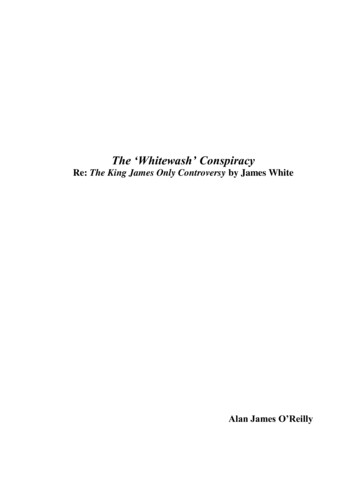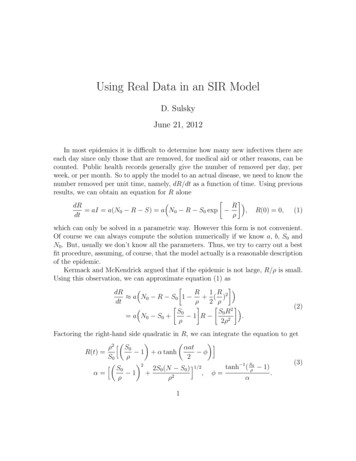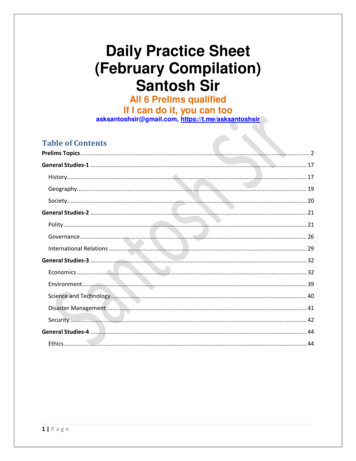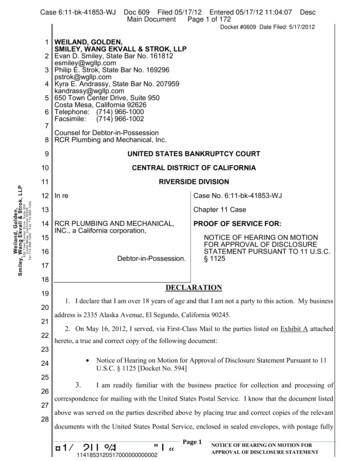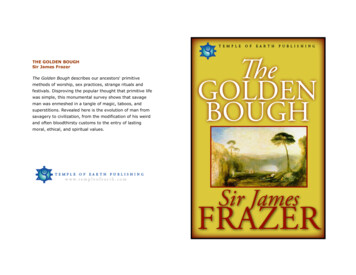
Transcription
THE GOLDEN BOUGHSir James FrazerThe Golden Bough describes our ancestors' primitivemethods of worship, sex practices, strange rituals andfestivals. Disproving the popular thought that primitive lifewas simple, this monumental survey shows that savageman was enmeshed in a tangle of magic, taboos, andsuperstitions. Revealed here is the evolution of man fromsavagery to civilization, from the modification of his weirdand often bloodthirsty customs to the entry of lastingmoral, ethical, and spiritual values.
THE GOLDEN BOUGHp . 2aJames Frazerp . 2bCONTENTSPrefaceTHE GOLDEN BOUGHA STUDY OFSubject IndexChapter 1. The King of the Wood1. Diana and VirbiusMAGIC AND RELIGION2. Artemis and Hippolytus3. RecapitulationChapter 2. Priestly KingsBYSIR JAMES GEORGE FRAZERChapter 3. Sympathetic Magic1. The Principles of Magic2. Homoeopathic or Imitative Magic3. Contagious Magic4. The Magician's ProgressChapter 4. Magic and ReligionChapter 5. The Magical Control of the Weather1. The Public Magician2. The Magical Control of Rain3. The Magical Control of the Sun
THE GOLDEN BOUGHp . 3a4. The Magical Control of the WindChapter 6. Magicians as KingsJames Frazerp . 3bChapter 16. Dianus and DianaChapter 17. The Burden of RoyaltyChapter 7. Incarnate Human Gods1. Royal and Priestly TaboosChapter 8. Departmental Kings of Nature2. Divorce of the Spiritual from theTemporal PowerChapter 9. The Worship of Trees1. Tree-spirits2. Beneficent Powers of Tree-SpiritsChapter 10. Relics of Tree Worship in ModernEuropeChapter 11. The Influence of the Sexes onVegetationChapter 12. The Sacred MarriageChapter 18. The Perils of the Soul1. The Soul as a Mannikin2. Absence and Recall of the Soul3. The Soul as a Shadow and a ReflectionChapter 19. Tabooed Acts1. Taboos on Intercourse with Strangers2. Taboos on Eating and Drinking1. Diana as a Goddess of Fertility3. Taboos on Showing the Face2. The Marriage of the Gods4. Taboos on Quitting the HouseChapter 13. The Kings of Rome and Alba1. Numa and Egeria2. The King as JupiterChapter 14. Succession to the Kingdom inAncient LatiumChapter 15. The Worship of the Oak5. Taboos on Leaving Food overChapter 20. Tabooed Persons1. Chiefs and Kings tabooed2. Mourners tabooed3. Women tabooed at Menstruation andChildbirth
THE GOLDEN BOUGHp . 4a4. Warriors tabooedJames Frazerp . 4b4. Names of Kings and other SacredPersons tabooed5. Manslayers tabooed5. Names of Gods tabooed6. Hunters and Fishers tabooedChapter 23. Our Debt to the SavageChapter 21. Tabooed ThingsChapter 24. The Killing of the Divine King1. The Meaning of Taboo1. The Mortality of the Gods2. Iron tabooed2. Kings killed when their Strength fails3. Sharp Weapons tabooed3. Kings killed at the End of a Fixed Term4. Blood tabooed5. The Head tabooed6. Hair tabooedChapter 25. Temporary KingsChapter 26. Sacrifice of the King's Son7. Ceremonies at Hair-cuttingChapter 27. Succession to the Soul8. Disposal of Cut Hair and NailsChapter 28. The Killing of the Tree-Spirit9. Spittle tabooed1. The Whitsuntide Mummers10. Foods tabooed2. Burying the Carnival11. Knots and Rings tabooed3. Carrying out DeathChapter 22. Tabooed Words4. Bringing in Summer1. Personal Names tabooed5. Battle of Summer and Winter2. Names of Relations tabooed6. Death and Resurrection ofKostrubonko3. Names of the Dead tabooed7. Death and Revival of Vegetation
THE GOLDEN BOUGHp . 5aJames Frazerp . 5b8. Analogous Rites in India3. Osiris a God of Fertility9. The Magic Spring4. Osiris a God of the DeadChapter 29. The Myth of AdonisChapter 41. IsisChapter 30. Adonis in SyriaChapter 42. Osiris and the SunChapter 31. Adonis in CyprusChapter 43. DionysusChapter 32. The Ritual of AdonisChapter 44. Demeter and PersephoneChapter 33. The Gardens of AdonisChapter 45. Corn-Mother and Corn-Maiden inN. EuropeChapter 34. The Myth and Ritual of AttisChapter 46. Corn-Mother in Many LandsChapter 35. Attis as a God of VegetationChapter 36. Human Representatives of AttisChapter 37. Oriental Religions in the WestChapter 38. The Myth of OsirisChapter 39. The Ritual of Osiris1. The Popular Rites2. The Official RitesChapter 40. The Nature of Osiris1. The Corn-mother in America2. The Rice-mother in the East Indies3. The Spirit of the Corn embodied inHuman Beings4. The Double Personification of theCorn as Mother and DaughterChapter 47. Lityerses1. Songs of the Corn Reapers2. Killing the Corn-spirit1. Osiris a Corn-god3. Human Sacrifices for the Crops2. Osiris a Tree-spirit4. The Corn-spirit slain in his HumanRepresentatives
THE GOLDEN BOUGHp . 6aChapter 48. The Corn-Spirit as an Animal1. Animal Embodiments of the CornspiritJames Frazerp . 6b1. The Sacrament of First-Fruits2. Eating the God among the Aztecs3. Many Manii at Aricia2. The Corn-spirit as a Wolf or a DogChapter 51. Homeopathic Magic of a Flesh Diet3. The Corn-spirit as a Cock4. The Corn-spirit as a Hare5. The Corn-spirit as a Cat6. The Corn-spirit as a Goat7. The Corn-spirit as a Bull, Cow, or Ox8. The Corn-spirit as a Horse or Mare9. The Corn-spirit as a Pig (Boar or Sow)10. On the Animal Embodiments of theCorn-spiritChapter 49. Ancient Deities of Vegetation asAnimals1. Dionysus, the Goat and the Bull2. Demeter, the Pig and the Horse3. Attis, Adonis, and the PigChapter 52. Killing the Divine Animal1. Killing the Sacred Buzzard2. Killing the Sacred Ram3. Killing the Sacred Serpent4. Killing the Sacred Turtles5. Killing the Sacred BearChapter 53. The Propitiation of Wild AnimalsBy HuntersChapter 54. Types of Animal Sacrament1. The Egyptian and the Aino Types ofSacrament2. Processions with Sacred AnimalsChapter 55. The Transference of Evil4. Osiris, the Pig and the Bull1. The Transference to Inanimate Objects5. Virbius and the Horse2. The Transference to AnimalsChapter 50. Eating the God3. The Transference to Men
THE GOLDEN BOUGHp . 7a4. The Transference of Evil in EuropeChapter 56. The Public Expulsion of Evils1. The Omnipresence of Demons2. The Occasional Expulsion of EvilsJames Frazerp . 7b2. Not to see the Sun3. The Seclusion of Girls at Puberty4. Reasons for the Seclusion of Girls atPubertyChapter 61. The Myth of Balder3. The Periodic Expulsion of EvilsChapter 62. The Fire-Festivals of EuropeChapter 57. Public Scapegoats1. The Fire-festivals in general1. The Expulsion of Embodied Evils2. The Lenten Fires2. The Occasional Expulsion of Evils in aMaterial Vehicle3. The Periodic Expulsion of Evils in aMaterial Vehicle3. The Easter Fires4. The Beltane Fires5. The Midsummer Fires4. On Scapegoats in General6. The Hallowe'en FiresChapter 58. Human Scapegoats in ClassicalAntiquity1. The Human Scapegoat in AncientRome2. The Human Scapegoat in AncientGreece3. The Roman SaturnaliaChapter 59. Killing the God in MexicoChapter 60. Between Heaven and Earth1. Not to touch the Earth7. The Midwinter Fires8. The Need-fireChapter 63. The Interpretation of the FireFestivals1. On the Fire-festivals in general2. The Solar Theory of the Fire-festivals3. The Purificatory Theory of the Firefestivals
THE GOLDEN BOUGHp . 8aJames Frazerp . 8bChapter 64. The Burning of Human Beings inthe Fires1. The Burning of Effigies in the Fires2. The Burning of Men and Animals inthe FiresChapter 65. Balder and the MistletoeChapter 66. The External Soul in Folk-TalesChapter 67. The External Soul in Folk-Custom1. The External Soul in Inanimate Things2. The External Soul in Plants3. The External Soul in Animals4. The Ritual of Death and ResurrectionChapter 68. The Golden BoughChapter 69. Farewell to NemiPrefaceTHE PRIMARY aim of this book is to explain theremarkable rule which regulated the succession to thepriesthood of Diana at Aricia. When I first set myself tosolve the problem more than thirty years ago, I thoughtthat the solution could be propounded very briefly, but Isoon found that to render it probable or evenintelligible it was necessary to discuss certain moregeneral questions, some of which had hardly beenbroached before. In successive editions the discussionof these and kindred topics has occupied more andmore space, the enquiry has branched out in more andmore directions, until the two volumes of the originalwork have expanded into twelve. Meantime a wish hasoften been expressed that the book should be issued ina more compendious form. This abridgment is anattempt to meet the wish and thereby to bring the workwithin the range of a wider circle of readers. While thebulk of the book has been greatly reduced, I haveendeavoured to retain its leading principles, togetherwith an amount of evidence sufficient to illustrate themclearly. The language of the original has also for themost part been preserved, though here and there theexposition has been somewhat condensed. In order tokeep as much of the text as possible I have sacrificed allthe notes, and with them all exact references to myauthorities. Readers who desire to ascertain the sourceof any particular statement must therefore consult thelarger work, which is fully documented and providedwith a complete bibliography.
THE GOLDEN BOUGHp . 9aIn the abridgment I have neither added new matter noraltered the views expressed in the last edition; for theevidence which has come to my knowledge in themeantime has on the whole served either to confirm myformer conclusions or to furnish fresh illustrations ofold principles. Thus, for example, on the crucialquestion of the practice of putting kings to death eitherat the end of a fixed period or whenever their healthand strength began to fail, the body of evidence whichpoints to the wide prevalence of such a custom has beenconsiderably augmented in the interval. A strikinginstance of a limited monarchy of this sort is furnishedby the powerful mediaeval kingdom of the Khazars inSouthern Russia, where the kings were liable to be putto death either on the expiry of a set term or wheneversome public calamity, such as drought, dearth, or defeatin war, seemed to indicate a failure of their naturalpowers. The evidence for the systematic killing of theKhazar kings, drawn from the accounts of old Arabtravellers, has been collected by me elsewhere.[1]Africa, again, has supplied several fresh examples of asimilar practice of regicide. Among them the mostnotable perhaps is the custom formerly observed inBunyoro of choosing every year from a particular clan amock king, who was supposed to incarnate the lateking, cohabited with his widows at his temple-tomb,and after reigning for a week was strangled.[2] Thecustom presents a close parallel to the ancientBabylonian festival of the Sacaea, at which a mock kingwas dressed in the royal robes, allowed to enjoy the realking’s concubines, and after reigning for five days wasstripped, scourged, and put to death. That festival in itsturn has lately received fresh light from certainAssyrian inscriptions,[3] which seem to confirm theinterpretation which I formerly gave of the festival as aNew Year celebration and the parent of the JewishJames Frazerp . 9bfestival of Purim.[4] Other recently discovered parallelsto the priestly kings of Aricia are African priests andkings who used to be put to death at the end of seven orof two years, after being liable in the interval to beattacked and killed by a strong man, who thereuponsucceeded to the priesthood or the kingdom.[5][1] J. G. Frazer, “The Killing of the Khazar Kings,” Folklore, xxviii. (1917), pp. 382–407.[2] Rev. J. Roscoe, The Soul of Central Africa (London,1922), p. 200. Compare J. G. Frazer, &147;The MackieEthnological Expedition to Central Africa,” Man, xx.(1920), p. 181.[3] H. Zimmern, Zum babylonischen Neujahrsfest(Leipzig, 1918). Compare A. H. Sayce, in Journal of theRoyal Asiatic Society, July 1921, pp. 440–442.[4] The Golden Bough, Part VI. The Scapegoat, pp. 354sqq., 412 sqq.[5] P. Amaury Talbot in Journal of the African Society,July 1916, pp. 309 sq.; id., in Folk-lore, xxvi. (1916), pp.79 sq.; H. R. Palmer, in Journal of the African Society,July 1912, pp. 403, 407 sq.With these and other instances of like customs beforeus it is no longer possible to regard the rule ofsuccession to the priesthood of Diana at Aricia asexceptional; it clearly exemplifies a widespreadinstitution, of which the most numerous and the mostsimilar cases have thus far been found in Africa. Howfar the facts point to an early influence of Africa onItaly, or even to the existence of an African population
THE GOLDEN BOUGHp . 10ain Southern Europe, I do not presume to say. The prehistoric historic relations between the two continentsare still obscure and still under investigation.James Frazerp . 10bviews by a comparison with my own expressdeclaration.J. G. FRAZER.Whether the explanation which I have offered of theinstitution is correct or not must be left to the future todetermine. I shall always be ready to abandon it if abetter can be suggested. Meantime in committing thebook in its new form to the judgment of the public Idesire to guard against a misapprehension of its scopewhich appears to be still rife, though I have sought tocorrect it before now. If in the present work I havedwelt at some length on the worship of trees, it is not, Itrust, because I exaggerate its importance in the historyof religion, still less because I would deduce from it awhole system of mythology; it is simply because I couldnot ignore the subject in attempting to explain thesignificance of a priest who bore the title of King of theWood, and one of whose titles to office was the pluckingof a bough—the Golden Bough—from a tree in thesacred grove. But I am so far from regarding thereverence for trees as of supreme importance for theevolution of religion that I consider it to have beenaltogether subordinate to other factors, and inparticular to the fear of the human dead, which, on thewhole, I believe to have been probably the mostpowerful force in the making of primitive religion. Ihope that after this explicit disclaimer I shall no longerbe taxed with embracing a system of mythology which Ilook upon not merely as false but as preposterous andabsurd. But I am to
methods of worship, sex practices, strange rituals and festivals. Disproving the popular thought that primitive life was simple, this monumental survey shows that savage man was enmeshed in a tangle of magic, taboos, and superstitions. Revealed here is the evolution of man from savagery to civilization, from the modification of his weird and often bloodthirsty customs to the entry of lasting .
